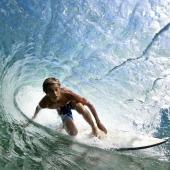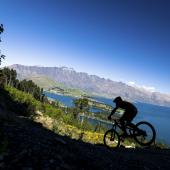Big Waves
Surfing is a dangerous sport. The bigger the waves, the greater the risk. They rear up slowly and mighty. Much larger and more gigantic than man. These wild and unruly appearances attracts surfers around the world magically. They meet at the most popular big waves hotspots of the world and ride the monsters from the ocean.
One refers to big waves from a height of six meters on. But for athletes like Ken Bradshaw, Sebastian Steudtner or Mick Fanning only from 20 meters on it gets really interesting. The 62-year-old American Ken Bradshaw once said: "When I was young, I interpreted surfing in a way that it all came down to the point that you can surf bigger waves than any other guy. And I truly believe that this is what surfing is all about."
Big wave surfing is an extreme sport. Here, not tanned golden boys surf the waves, but rather professionals who are fascinated by dark and huge waves. For those who lose control over the board in these extremely heavy water masses it can get dangerous to life. Experts disagree of course. They consider themselves as specialists who know everything they need to know to ride the monster waves. Thus the extreme athletes need to dominate and hide the fear aspect. Nevertheless, big wave surfer show respect for the great waves. Actually, they need this respect which enables them to react in dangerous situations without thinking.
For many big wave surfers also their partners are very important. Because starting at a certain size of the wave, one does not get that close to it. The force with which it breaks then is that powerful that surfers have no chance to paddle with muscle power behind the spray. That's why the surfers enter the water with the person who rides the jet-ski. He pulls the surfer to the suitable position of the wave using a rope - and also retrieves her or him when she or he falls. This is called tow surfing. Surfer and driver usually alternate.
Ken Bradshaw was one of the first who has practiced this kind of surfing in the 60s and 70s. But only at the early 90s, tow surfing prevailed slowly. As a result, the scale of the waves one which one can surf has increased significantly.
The biggest waves are located at specific surf spots in the world. In December every year in Hawaii the "Big Wave Challenge" takes place. Between late April and mid-August, each time when the conditions are best, the Australian Mark Mathews rounds up the twelve world's top big wave surfers to surf at Cape Solander in Botany Bay, also called "Ours". The waves of Nazaré, which are located on the Portuguese Atlantic coast, are the biggest surfable waves in the world under appropriate conditions. Here, the surfer Garrett McNamara received his entry in the Guinness Book of Records, as he surfed a 23-meter-high wave. On May 1st, 2015 Sebastian Steudtner received the "XXL Big Wave Award" in the category "Biggest Wave" for a ride on an estimated 21.6 meters high wave off the coast of Nazaré.




